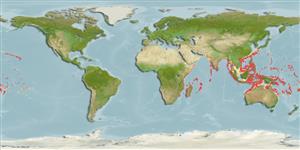Common names from other countries
>
Eupercaria/misc (Various families in series Eupercaria) >
Lutjanidae (Snappers) > Etelinae
Etymology: Pristipomoides: Greek, pristis = saw + Greek, poma, -atos = cover, operculum + Greek, oides = similar to (Ref. 45335).
More on author: Valenciennes.
Environment: milieu / climate zone / depth range / distribution range
Ökologie
seewasser benthopelagisch; tiefenbereich 70 - 300 m (Ref. 9821), usually 125 - 275 m (Ref. 82366). Deep-water; 35°N - 29°S, 34°E - 146°W (Ref. 55)
Indo-Pacific: East Africa to Hawaii and Tahiti, north to southern Japan, south to Australia and Lord Howe Island.
Size / Gewicht / Alter
Maturity: Lm ? range ? - ? cm
Max length : 57.5 cm FL Männchen/unbestimmt; (Ref. 107958); common length : 35.0 cm TL Männchen/unbestimmt; (Ref. 30573); max. veröff. Gewicht: 1.8 kg (Ref. 4887)
Rückenflossenstacheln (insgesamt): 10; Rückenflossenweichstrahlen (insgesamt): 10-11; Afterflossenstacheln 3; Afterflossenweichstrahlen: 8. Interorbital space convex. Jaws about equal, or lower jaw slightly protruding. Bases of dorsal and anal fins without scales, their last soft rays extended into short filaments. Pectoral fins long, reaching level of anus. Scale rows on back parallel to lateral line. Overall color pink or reddish with four oblique orange or yellow bars on the sides; the dorsal and caudal fins yellow.
Adults occur over rocky bottoms (Ref. 30573) of the continental shelf and slope (Ref. 75154). They feed on fishes, shrimps, crabs, cephalopods, miscellaneous benthic invertebrates and pelagic organisms, including urochordates.
Life cycle and mating behavior
Geschlechtsreife | Fortpflanzung | Ablaichen | Eier | Fecundity | Larven
Allen, G.R., 1985. FAO Species Catalogue. Vol. 6. Snappers of the world. An annotated and illustrated catalogue of lutjanid species known to date. FAO Fish. Synop. 125(6):208 p. Rome: FAO. (Ref. 55)
IUCN Rote Liste Status (Ref. 130435)
CITES (Ref. 128078)
Not Evaluated
Bedrohung für Menschen
Harmless
Nutzung durch Menschen
Fischereien: kommerziell; Sportfisch: ja
Mehr Information
NamenSynonymeMetabolismusRäuberÖkotoxikologieFortpflanzungGeschlechtsreifeAblaichenFecundityEierEientwicklung
ReferenzenAquakulturAquakultur ProfilZuchtlinienGenetikElectrophoresesVererbbarkeitKrankheitenVerarbeitungMass conversion
PartnerBilderStamps, Coins Misc.LauteCiguateraGeschwindigkeitSchwimmstilKiemenoberflächeOtolithsGehirngrößeSehfähigkeit
Tools
Zusatzinformationen
Download XML
Internet Quellen
Estimates based on models
Preferred temperature (Ref.
115969): 12.3 - 23, mean 16.9 (based on 356 cells).
Phylogenetic diversity index (Ref.
82804): PD
50 = 0.5005 [Uniqueness, from 0.5 = low to 2.0 = high].
Bayesian length-weight: a=0.01349 (0.00781 - 0.02329), b=2.94 (2.80 - 3.08), in cm Total Length, based on LWR estimates for this species & Genus-body shape (Ref.
93245).
Trophic level (Ref.
69278): 4.0 ±0.0 se; based on diet studies.
Widerstandsfähigkeit (Ref.
120179): mittel, Verdopplung der Population dauert 1,4 - 4,4 Jahre. (K=0.23).
Fishing Vulnerability (Ref.
59153): Moderate vulnerability (42 of 100).
